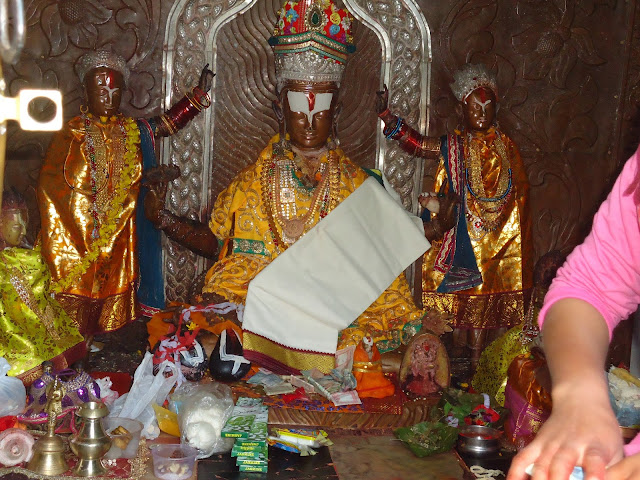NEPAL TOUR AND PILGRIMAGE - PART III MANAKAMANA DEVI
The initial itinerary for Manakamana Devi darshan as per the earlier programme was on 1st October 2015 and while going to Pokhara from Kathmandu but due to the fuel supply crisis, that was postponed to 3rd October 2015. Hence we went to Manakamana Devi temple on our return from Pokhara to Kathamandu. Manakamanadevi temple is at a height of 4272 ft above seal level on a ridge of a mountain and on the foot of the hill, river Trisuli flows in the south and Marsyangdi river in the West. The distance of 2.8 kms is covered by the rope car in about 10 to 12 minutes and this rope car facility was inagurated in 1998. The bottom station of cable car is in Cheres at a height of 846 ft above seal level and is in Gorkha district of Nepal.
Entrance to Ropeway, Manakamanadevi, Gorkha District
View from Manakamana Ropeway, river Trisuli can be seen
The story of the temple dates back to 17th century and during the reign of King Ram Shah. The queen was an incarnation of the Goddess Parvathi and the king one day in his dreams found the queen to be Goddess and her devotee Lakhan Thapa the lion of the goddess. Upon mentiioning the revelation, death befell on the King and as per the custom during the period the Queen committed Sati. But before that, the Queen told Lakhan Thapa that she would come back in the near future. A few months later, while a farmer was ploughing the fields, he saw blood and milk coming out of a cleaved stone. Knowing the same, Lakhan Thapa understood that the Queen is reborn and conducted Hindu tantric rituals and stopped the flow of blood and milk. This became the foundation for the shrine at the present place of Manakamana Devi and the descendents of Lakhan Thapa are the priests in the temple so for.The temple had damages earlier too in an earthquake in 1934 and 2015 earquake destroyed the main temple. Presently the deity is kept in a small shed and work is in progress to reconstruct the temple.
Manakamana is mana meaning mind and kamana is wish and the goddess fulfills the wishes of the devotees.
Temple razed to ground in the earthquake, 2015
Normally tourists, visit the temple, which is between Kathmandu and Pokhara from either end.
The initial itinerary for Manakamana Devi darshan as per the earlier programme was on 1st October 2015 and while going to Pokhara from Kathmandu but due to the fuel supply crisis, that was postponed to 3rd October 2015. Hence we went to Manakamana Devi temple on our return from Pokhara to Kathamandu. Manakamanadevi temple is at a height of 4272 ft above seal level on a ridge of a mountain and on the foot of the hill, river Trisuli flows in the south and Marsyangdi river in the West. The distance of 2.8 kms is covered by the rope car in about 10 to 12 minutes and this rope car facility was inagurated in 1998. The bottom station of cable car is in Cheres at a height of 846 ft above seal level and is in Gorkha district of Nepal.
Entrance to Ropeway, Manakamanadevi, Gorkha District
View from Manakamana Ropeway, river Trisuli can be seen
The story of the temple dates back to 17th century and during the reign of King Ram Shah. The queen was an incarnation of the Goddess Parvathi and the king one day in his dreams found the queen to be Goddess and her devotee Lakhan Thapa the lion of the goddess. Upon mentiioning the revelation, death befell on the King and as per the custom during the period the Queen committed Sati. But before that, the Queen told Lakhan Thapa that she would come back in the near future. A few months later, while a farmer was ploughing the fields, he saw blood and milk coming out of a cleaved stone. Knowing the same, Lakhan Thapa understood that the Queen is reborn and conducted Hindu tantric rituals and stopped the flow of blood and milk. This became the foundation for the shrine at the present place of Manakamana Devi and the descendents of Lakhan Thapa are the priests in the temple so for.The temple had damages earlier too in an earthquake in 1934 and 2015 earquake destroyed the main temple. Presently the deity is kept in a small shed and work is in progress to reconstruct the temple.
Manakamana is mana meaning mind and kamana is wish and the goddess fulfills the wishes of the devotees.
Temple razed to ground in the earthquake, 2015
The temple reconstruction is going on and whether will it be the same as it was looking earlier as shown below.
Normally tourists, visit the temple, which is between Kathmandu and Pokhara from either end.





















